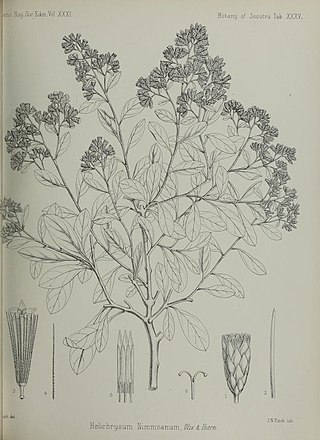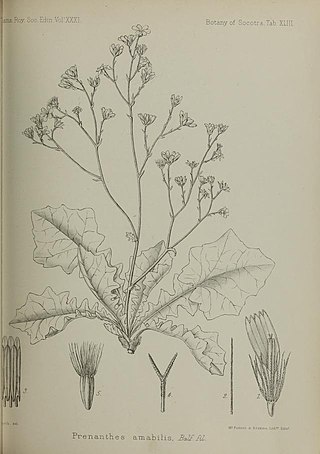
Leucas is a genus of plants in the family Lamiaceae, first described by Robert Brown in 1810. It contains over 200 species, widespread over much of Africa, and southern and eastern Asia with a few species in Queensland and on various islands in the Indian Ocean.

The Gnaphalieae are a tribe of flowering plants in the family Asteraceae. It is most closely related to the tribes Anthemideae, Astereae, and Calenduleae.

The genus of the myrrhs, Commiphora, is the most species-rich genus of flowering plants in the frankincense and myrrh family, Burseraceae. The genus contains approximately 190 species of shrubs and trees, which are distributed throughout the (sub-) tropical regions of Africa, the western Indian Ocean islands, the Arabian Peninsula, India, and South America. The genus is drought-tolerant and common throughout the xerophytic scrub, seasonally dry tropical forests, and woodlands of these regions.

Distephanus is a genus of flowering plants in the family Asteraceae. It is described by American botanist Harold E. Robinson as having over 40 species and by David Mabberley as having only 34 species. These sources differ sharply in their description of the range of the genus. Robinson has it ranging throughout Africa and occurring also in India and China. Mabberley has it restricted to southeast Africa, Madagascar, and Mauritius.

Libinhania acicularis, synonym Helichrysum aciculare, is a species of flowering plant in the family Asteraceae. It lives only in Socotra. Its natural habitat is rocky areas.
Libinhania arachnoides, synonym Helichrysum arachnoides, is a species of flowering plant in the family Asteraceae. It is endemic to Socotra. Its natural habitat is subtropical or tropical dry forests.
Libinhania balfourii, synonym Helichrysum balfourii, is a species of flowering plant in the family Asteraceae. It is endemic to Socotra. Its natural habitat is subtropical or tropical dry forests.

Libinhania nimmoana, synonym Helichrysum nimmoanum, is a species of flowering plant in the family Asteraceae. It is endemic to the island of Socotra in Yemen. Its natural habitat is subtropical or tropical dry forests.

Libinhania rosulata, synonym Helichrysum rosulatum, is a species of flowering plant in the family Asteraceae. It is endemic to Socotra. Its natural habitat is rocky areas.
Libinhania sphaerocephala, synonym Helichrysum sphaerocephalum, is a species of flowering plant in the family Asteraceae. It is endemic to Socotra. Its natural habitats are subtropical or tropical dry forests, subtropical or tropical dry shrubland, and rocky areas.

Libinhania suffruticosa, synonym Helichrysum suffruticosum, is a species of flowering plant in the family Asteraceae. It is endemic to Socotra. Its natural habitat is subtropical or tropical dry forests.

Erythroseris amabilis is a species of flowering plant in the family Asteraceae. It is found only in the Socotra Islands, part of the Republic of Yemen. Its natural habitats are subtropical or tropical dry forests and rocky areas. It is listed as an endangered species by the IUCN under the basionym Prenanthes amabilis.

Pulicaria is a genus of flowering plant in the sunflower family, native to Europe, Asia, and Africa. In North America Pulicaria is known by the common name false fleabane.

Hypericum scopulorum is a species of flowering plant in the family Hypericaceae. It is endemic to Socotra, an island archipelago that is part of Yemen. It is a common plant in shrubland habitat, and it is a dominant species in some areas along with Cephalocroton and another local endemic, Libinhania rosulata.
Aloe jawiyon is a species of succulent plant in the genus Aloe first described in 2004. It is endemic to the island of Socotra, Yemen, located in the Indian Ocean, approximately 200 miles off of the southwestern coast of the Arabian Peninsula and around 430 miles east of the coast of Somalia.

Aloe perryi is a species of plant in the genus Aloe. It is endemic to the island of Socotra in Yemen, and may be known by the common name, Socotrine aloe.

Aloe squarrosa is a species of flowering plant in the Asphodelaceae family. It is from the island of Socotra, Yemen.
Amal Amin is an Egyptian botanist.
Erythroseris is a genus of African plants in the tribe Cichorieae within the family Asteraceae.
Orbivestus is a genus of shrubs in the family Asteraceae, native to tropical Africa, the Arabian Peninsula and the Indian subcontinent. Its species were formerly placed in the genus Vernonia.











